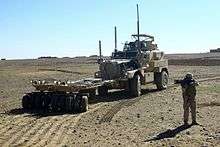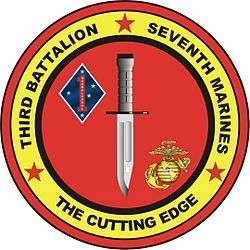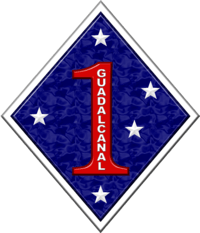3rd Battalion 7th Marines
| 3rd Battalion 7th Marine Regiment | |
|---|---|
|
3/7 insignia | |
| Active | 1 January 1941 – present |
| Allegiance |
|
| Branch |
|
| Type | Infantry |
| Size | 1,200 |
| Part of |
7th Marine Regiment 1st Marine Division |
| Garrison/HQ | Marine Corps Air Ground Combat Center Twentynine Palms |
| Nickname(s) | The Blade |
| Engagements |
Operation Desert Storm
|
| Commanders | |
| Commanding Officer | Lieutenant Colonel A. J. Nelson |
| Senior Enlisted | Sergeant Major R. K. Hampton |
The 3rd Battalion 7th Marine Regiment (3/7) is an infantry battalion of the United States Marine Corps. They are based at the Marine Corps Air Ground Combat Center Twentynine Palms and consist of approximately 800 Marines. The battalion falls under the command of the 7th Marine Regiment and the 1st Marine Division. The battalion has seen combat in World War II, the Korean War, the Vietnam War, the Gulf War and was a part of the main effort during the initial invasion of Iraq in 2003. They have since deployed five times in support of Operation Iraqi Freedom as well as three times in support of Operation Enduring Freedom, and continue operations in Afghanistan. The unit has a long, decorated history with countless achievements. Its members were described as "true professionals" by embedded reporters during the 2003 invasion of Iraq.
History
World War II
3rd Battalion 7th Marines was activated 1 January 1941 at Guantanamo Bay, Cuba and was assigned to the 1st Marine Brigade. In February 1941 they were reassigned to the 1st Marine Division. 3/7 participated in the following World War II campaigns:
- Guadalcanal.
- Eastern New Guinea.
- New Britain.
- Peleliu.
- Okinawa.
After the war 3/7 participated in the occupation of northern China from September 1945 to April 1946 and then deactivated 15 April 1946.
Korean War
The battalion was reactivated 11 September 1950 at Kobe, Japan and assigned to the 1st Marine Division. They deployed in September 1950 to the South Korea and participated in the Inchon-Seoul. Following the recapture of Seoul, the 1st Marine Division was pulled out of northwest Korea and sailed to the east coast where they landed at Wonsan and began to march north towards the Yalu River.
The battalion was in Yudam-ni on the evening of 27–28 November 1950 when the Battle of Chosin Reservoir began. On the first evening, the Marines of "How Company" were overwhelmed on Hill 1403 by waves of Chinese attackers and were eventually ordered to pull back by the commanding officer (CO), Lieutenant Colonel William Harris[1] The battalion continued to fight on the hills around Yudam-ni for the next few days until 1 December[2] when the 5th Marines and 7th Marines were ordered to fight their way back to the 1st Marine Division’s main perimeter at Hagaru-ri. The 300+ remaining members of 3/7[3] provided the rearguard for the two regiments as they brokeout to Hagaru-ri and were the last Marines to leave the perimeter at Yudam-ni as it was being overrun by Chinese forces[4] 3/7 consolidated with the rest of the division at Hagaru-ri and took part in the fighting breakout towards Koto-ri where, on 7 December, all of the 1st Marine Division’s regiments were together for the first time since the landing at Wonsan in October[5] Of note during the battle, on the morning before their arrival at the Koto-ri perimeter, the battalion’s CO, who during the battle was described as “coming apart”[6] and having an “emotional breakdown and collapse”,[7] disappeared and was never seen again.[8]
During the rest of the war 3/7 took part in the fighting on the East Central Front. In October 1951 it performed the first battalion sized combat helicopter air assault in history in Operation Bumblebee.[9] After the war the battalion participated in the defense of the Korean Demilitarized Zone, July 1953 to March 1955.
Vietnam War
The 3rd Battalion, along with the rest of the 7th Marines, was deployed to Vietnam from Camp Pendleton in late May 1965. The 3/7, under the command of LTC Charles H. Bodley, embarked on the amphibious ships USS Iwo Jima (LPH-2), USS Talladega (APA-208), and USS Point Defiance (LSD-31) at Okinawa on 24–26 June and landed near the city of Qui Nhon on 1 July 1965.[10]
On 18 August 1965, the 3/7 took part in Operation Starlite, the first regimental size operation by US forces since the Korean War. The 3/7, along with the 3rd Battalion, 3rd Marines, and the 2nd Battalion, 4th Marines, made a combined amphibious-helicopter assault on fortified enemy positions on the Van Tuong Peninsula. The Marines landed behind enemy lines and, after seven days of fighting, drove the 1st Viet Cong Regiment into the sea.[11]
In January 1966, the 3/7 took part in Operation Mallard along with the 3rd Battalion, 3rd Marines. It was a sweep of the area 20 miles southwest of Da Nang, in the area later known as the Arizona Territory. While the Viet Cong did not engage in major confrontations with the Marines during Operation Mallard, the area would later be a significant battleground for the 3/7 and other Marine battalions in the years to come.[12]
In March 1966 the battalion took part in Operation Texas. On 18 March 1966 an ARVN outpost on Hill 141 west of Quang Ngai City was overrun by the 36th North Vietnamese Regiment. A reaction/relief force was promptly put together consisting of elements from 4 Marine battalions including 3/7 and an ARVN battalion. The allied forces were inserted by ground and air on 20 and 21 March and began closing around the NVA forces. Over the next four days, Operation Texas claimed a total of 623 known enemy dead, but at least 57 US Marines and sailors were killed in a series of bitter fights.
Along with the 1/7, 2/7 and elements of the 26th Marines and 51st ARVN regiment, the 3/7th also took part in Operation Oklahoma Hills from March through May 1969, an operation to clear NVA base camps and infiltration routes out of the hills and valleys southwest of Da Nang, South Vietnam's second most important city and a major base for US operations at the time.[13]
For "conspicuous gallantry and intrepity at the risk of his life above and beyond the call of duty" and "in the face of vicious enemy fire" during a search and destroy mission in the Que Son-Hiep Duc Valley on 28 August 1969, in which he destroyed several of the enemy and silenced anti-aircraft guns and machinegunist, Lance Corporal Jose F. Jimenez of Kilo Company, 3/7, was posthumously awarded the Medal of Honor.[14]
Persian Gulf War and Somali Civil War
During the 1990-91 Persian Gulf War, 3/7 took part in Operation Desert Storm. The battalion arrived in Jubail, Saudi Arabia, in mid-January 1991, with the mission to be a foot-mobile infiltration force. For a month from mid-February onwards, 3/7—as part of Task Force Grizzly, which mainly consisted of 3/7 and 2nd Battalion 7th Marines—took up position along a berm near the Saudi–Kuwaiti border. There, 3/7 became the lead element of all U.S. forces in the region. The battalion moved out of Saudi Arabia and into Kuwait three days before the ground offensive began on February 24, and then became the first allied infantry force to enter Kuwait. After breaching two enemy minefields, 3/7 took over Ahmed Al Jaber Air Base, which was believed to be the main command post for all enemy forces in Kuwait. The battalion departed Saudi Arabia in early March.[15]
From January to March 1995, elements of the battalion—namely Kilo Company, augmented with elements from India Company, Lima Company, and Weapons Company—participated in Operation United Shield in Somalia.
Global War on Terror
_Dr._Donald_C._Winter_addresses_Marines_assigned_to_the_3rd_Battalion%2C_7th_Marines_about_their_missions_and_to_find_out_how_things_are_going.jpg)
- 1st Tour
3/7 was part of the main effort, and took a major role in the 2003 invasion of Iraq. The premier infantry combat unit in the world, they originally deployed in January 2003, moved north in March and reached Baghdad by April - securing several cities, military bases, terrorist training facilities, and various other objectives along the way. They then moved south for a five-month security assignment doing stabilizing operations in Karbala until September 2003. During the assignment, India Company, 3rd Battalion 7th Marines operated in Mahmudiyah, Iraq in support of Task Force Scorpion during July and August 2003. Lima Company, 3rd Battalion 7th Marines were tasked out with the training of the Iraqi Police force, intelligence gathering, disruption and dismantling of the black market weapons trade, and both daytime and clandestine operations in coalition with CIA, Delta Force, and various other units in support to carry out special assignments. Lima Company's 3rd platoon, 2nd squad, is responsible for capturing and detaining some of the highest ranking Ba'ath Party members to date during covert operations south of Baghdad. India Company's training in the Kuwaiti desert and the subsequent invasion was covered in the TV documentary Virgin Soldiers which often airs on Discovery Times and Military Channel.
- 2nd Tour
After returning to the United States in September 2003, the battalion re-deployed in February 2004 to Al Qaim—in western Al Anbar Province, abutting the Syrian border. Their area of responsibility included Husaybah, the primary border-crossing point between Syria and Iraq. They returned from that deployment in September 2004.
- 3rd Tour
From September 2005 to March 2006 3/7 was stationed in Ar Ramadi and made FOB Hurricane Point (HP) and Camp Ramadi their main base of operations. They were faced with daily attacks for the entire deployment.
- 4th Tour (OIF 06-08)
From May 2007 to November 2007 3/7 was once again stationed in Ar Ramadi and made FOB Hurricane Point (HP) and Camp Ramadi their main base of operations. They dispersed throughout the city to increase contact with the local residents. Since the prevalence of the Anbar Awakening, 3/7 Marines began conducting counter-insurgency (COIN) missions rather than the more "kinetic" operations on previous tours.
- 5th Tour
3/7 re-deployed in support of OIF again in August 2008, once again to the Al Qaim area—in western Al Anbar Province, abutting the Syrian border. Their area of responsibility was much larger than any other time, including Husaybah to the west, all the way east to Hit. Due to status of forces agreements with the Iraqi government, operations were very limited and the battalion served in an "operational overwatch" role for the Iraqi forces. They returned from that deployment in March 2009.
- 6th Tour
3/7 deployed to Helmand province, Afghanistan from March 2010 to October 2010. During this deployment, the Marines of 3/7 faced daily attacks and operated in various locations including Musa Qaleh, Marjah, and Sangin. In Sangin, 3/7 relieved the 40 Commando of the British Royal Marines and began clearing operations in some of the most dangerous areas of Afghanistan. The Marines of 3/7 encountered heavy resistance and are reported to have experienced some of the highest amounts of enemy contact during the Global War on Terrorism.
- 7th Tour
In September and October 2011, 3/7 relieved 1/5 and elements of 1/6 in both the "green" and "brown" zones of the Sangin District for a second tour in support of Operation Enduring Freedom. The battalion conducted daily security patrols along with several clearing operations in an environment heavily laced with IED's. The battalion took 7 KIA and returned home in April 2012.
- 8th Tour
In September 2013, 3/7 returned to Northern Helmand province and relieved 3rd Battalion, 4th Marines, in Afghanistan for a third tour in support of Operation Enduring Freedom. The Battalion conducted distributed operations providing support to the Afghan Security Forces with companies located in Musa Q'ala, Sangin, Kajaki and FOB Shukvani in the Southern Musa Q'ala Wadi. This deployment was much different than the two previous as the Battalion was focused on supporting the Afghan Security Forces and conducting retrograde operations by transferring the Combat Outposts to the Afghan National Army. India Co, as well as Kilo Co, tactically enabled by British SAS and Afghan Special Forces, conducted various offensive operations in 5 districts within Afghanistan.

Medal of Honor recipients
- World War II
- PFC Arthur J. Jackson - 18 September 1944
- PFC Wesley Phelps - 4 October 1944
- Korean War
- 2ndLt Robert D. Reem - 6 November 1950
- Sgt James E. Johnson - 2 December 1950
- 2ndLt George H. Ramer - 12 September 1951
- SSgt William E. Shuck, Jr. - 3 July 1952
- Pvt Jack W. Kelso - 2 October 1952
- SSgt Lewis G. Watkins - 7 October 1952
- 2ndLt George H. O'Brien, Jr. - 27 October 1952
- Vietnam War
- LCpl Roy M. Wheat - 11 August 1967
- HM3 Wayne M. Caron - 28 July 1968
- LCpl Kenneth L. Worley - 12 August 1968
- LCpl Lester W. Weber - 23 February 1969
- LCpl Jose F. Jimenez - 28 August 1969
- LCpl James D. Howe - 6 May 1970
- Iraq War
- Cpl Jason Dunham - 22 April 2004[16]
Unit awards
A unit citation or commendation is an award bestowed upon an organization for the action cited. Members of the unit who participated in said actions are allowed to wear on their uniforms the awarded unit citation. 3rd Battalion, 7th Marines has been presented with the following awards:
| Streamer | Award | Year(s) | Additional Info |
|---|---|---|---|
| Presidential Unit Citation Streamer with one Silver and four Bronze Stars | 1942, 1944, 1945, 1950, 1950, 1951, 1965–1966, 1966–1967, 1967–1968, 2003 | Guadalcanal, Peleliu-Ngesebus, Okinawa, Korea, Vietnam, Iraq | |
| Navy Unit Commendation Streamer with two Bronze Stars | 1952–1953, 1965, 1990–1991 | Korea, Vietnam, Southwest Asia | |
| Meritorious Unit Commendation Streamer | 1968, 1968, 1969, 1990 | Vietnam, Philippines | |
| Armed Forces Expeditionary Medal Streamer | |||
| American Defense Service Streamer with one Bronze Star | 1941 | World War II | |
| Asiatic-Pacific Campaign Streamer with one Silver Star | Guadalcanal, Eastern New Guinea, New Britain, Peleliu, Okinawa | ||
| World War II Victory Streamer | 1941–1945 | Pacific War | |
| Navy Occupation Service Streamer with "ASIA" | 1945–1946 | Northern China | |
| China Service Streamer with one Bronze Star | September 1946 - June 1947 | North China | |
| National Defense Service Streamer with three Bronze Stars | 1950–1954, 1961–1974, 1990–1995, 2001–present | Korean War, Vietnam War, Gulf War, War on Terrorism | |
| Korean Service Streamer with one Silver and two Bronze Stars | Korean War | ||
| Vietnam Service Streamer with two Silver and three Bronze Stars | July 1965 - April 1971, April - December 1975 | ||
| Southwest Asia Service Streamer with two Bronze Stars | September 1990 - February 1991 | Desert Shield, Desert Storm | |
| Iraq Campaign Streamer | 2003–present | ||
| Global War on Terrorism Expeditionary Streamer | March - May 2003 | ||
| Global War on Terrorism Service Streamer | 2001–present | ||
| Korea Presidential Unit Citation Streamer | |||
| Vietnam Gallantry Cross with Palm Streamer | |||
| Vietnam Meritorious Unit Citation Civil Actions Streamer | |||
In popular culture
In the 1999 film The Sixth Sense, Haley Joel Osment's character asks Bruce Willis' character, "Do you want to be a Lance Corporal in Company M, Third Battalion, Seventh Marines?" while offering him a toy soldier.
See also
Notes
- ↑ Russ (1999), pp.115-121
- ↑ Russ (1999), p. 305
- ↑ Russ (1999), p. 324
- ↑ Russ (1999), p. 326
- ↑ Russ (1999), p. 394.
- ↑ Russ (1999), p. 121
- ↑ Russ (1999), p.168
- ↑ Russ (1999), p. 371.
- ↑ Parker, Gary W. (1978). A History of Marine Medium Helicopter Squadron 161 (PDF). Washington, D.C.: United States Marine Corps History and Museums Division. p. 6. Retrieved 2010-06-25.
- ↑ Victor J. Villinois, A Brief History of the 7th Marines, 1965-1970, http://www.marzone.com/7thMarines/Hst0001.htm, accessed 22 July 2012.
- ↑ Villinois, A Brief History of the 7th Marines.
- ↑ Villinois, A Brief History of the 7th Marines
- ↑ Charles Richard Smith, U.S. Marines in Vietnam: High Mobility and Standdown, 1969 (Washington, DC: History and Museums Division, Headquarters U. S. Marines, 1988), pp. 103-116.
- ↑ Villinois, A Brief History of the 7th Marines.
- ↑ Pomykal, Andrew D. (January 28, 2001). "Marines remember the 100-hour war known as Desert Storm". Lejeune Marines. Retrieved January 30, 2014.
- ↑ Gidget Fuentes (10 November 2006). "Medal of Honor is first for a Marine since Vietnam". Marine Corps Times.
http://projects.militarytimes.com/citations-medals-awards/recipient.php?recipientid=23294
References
 This article incorporates public domain material from websites or documents of the United States Marine Corps.
This article incorporates public domain material from websites or documents of the United States Marine Corps.
- Russ, Martin (1999). Breakout - The Chosin Reservoir Campaign, Korea 1950. Penguin Books. ISBN 0-14-029259-4.
- Web


